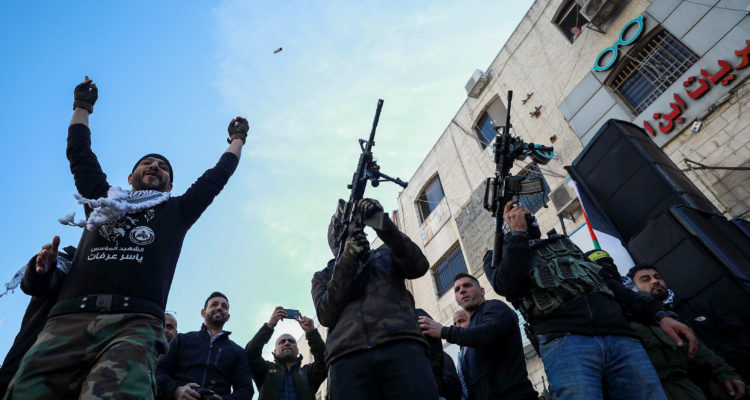The PA’s failure to crack down on the ‘battalions’ means that Iran now has a small army in Judea and Samaria.
By Khaled Abu Toameh, Gatestone Institute
The armed wing of the Iran-backed Palestinian Islamic Jihad (PIJ) announced on August 26 that five of its members were “martyred while performing their combat duty in the West Bank.”
One of the gunmen, Yazan Daraghmeh, a commander of the Tubas Battalion militia, was killed in a “work accident”: while planting an explosive device that was supposed to be used against Israel Defense Forces (IDF) soldiers in his hometown of Tubas in northern Judea and Samaria.
The four other gunmen, Oday Abu Naasa, Ahmed al-Anteer, Taher Raddad, and Mosab al-Muqasqas, were killed in recent clashes with the IDF.
They belonged to similar armed groups in the cities of Jenin and Tulkarem, also located in northern Judea and Samaria.
Armed and funded by Iran, the “battalions,” whose members are affiliated with PIJ, Hamas and the ruling Fatah faction headed by Palestinian Authority (PA) President Mahmoud Abbas, began operating in northern Judea and Samaria more than three years ago.
Since then, gunmen belonging to these groups have carried out countless attacks against Israeli civilians and soldiers.
Recently, the gunmen started using improvised explosive devices (IEDs) against Israeli civilian and military vehicles.
It is worth noting that some of these militias are based only a few hundred meters away from Israeli communities, both in Judea and Samaria and inside Israel.
In May, Hamas terrorists in Tulkarem recorded themselves shooting toward Bat Hefer, an Israeli town near the border of Judea and Samaria.
“Iran-supported Islamist militias are currently engaged in war against Israel on two fronts,” wrote British-Israeli analyst and journalist Jonathan Spyer, an expert on radical Islamic groups.
“The main focus of combat remains, of course, the Hamas-controlled Gaza Strip.
“A ‘support front,’ as is the preferred term, has been maintained by Lebanese Hezbollah since October 8 in the Israel-Lebanon border area.
“Iran seeks as a strategic objective to surround Israel with a crescent of active fronts maintained by Iran and supported by Islamist client militias. As part of this, the [Iranian] regime is seeking to find a way to add an eastern component to this crescent – through Jordan to the West Bank…
“Tehran has succeeded in establishing and maintaining an arms route in which military materiel, brought from Iran into Lebanon, is then transported across the Syrian-Lebanese border, via Jordan, into the West Bank.
“The maintenance of this route is of strategic importance to Iran. It is intended, over time, to flood the West Bank with weaponry, and by so doing, to eventually make this area a third front in the ongoing long war against Israel.”
Many gunmen are said to have joined the “battalions” in Judea and Samaria, especially in areas controlled by Mahmoud Abbas’s Palestinian Authority (PA).
The PA security forces, however, haven’t really done anything to disband or disarm the terrorists.
This is the same PA that, since its establishment 30 years ago, did nothing except watch while Hamas expanded throughout the Gaza Strip, eventually taking control over the entire coastal enclave in 2007.
The PA’s failure to crack down on the “battalions” means that Iran now has a small army in Judea and Samaria.
It will not be long before members of this army attack Israel in the same way as the October 7, 2023 Hamas-led invasion of Israel, in which 1,200 Israelis were murdered, with many raped, tortured and burned alive.
In addition, more than 240 Israelis, including babies, women and the elderly, were abducted to the Gaza Strip, where 109 of them are still being held as hostages.
Those who persist in advocating for the establishment of a Palestinian state next to Israel must take into consideration that doing so would lead to the rise of more Iran-backed “battalions” in Judea and Samaria and other areas over which the PA is given control.
Since the gunmen are frequently praised as “heroes” by many Palestinians, neither Abbas nor anyone who replaces him would have the courage to take them on.
Instead of ordering his security forces to crack down on the “battalions,” Abbas appears to have other priorities. He is evidently planning to return to the Gaza Strip. In a recent speech before Turkey’s Parliament, Abbas declared:
“I have decided to head with all members of the Palestinian leadership to the Gaza Strip, and I will work with all my energy to be with our people, as our lives are not more precious than the life of any Palestinian child.”
On August 25, a committee set up by Abbas to prepare for the return of the Palestinian Authority to the Gaza Strip decided to “contact the political bureau of Hamas and other Palestinian factions in order to agree and reach an understanding with them” on Abbas’s plans to head to the coastal enclave.
Abbas, it seems, believes that he can reach an advantageous deal with Hamas, whose members staged a bloody coup against his PA in 2007 and were preparing to assassinate him.
The PA will never be able to assume control of the Gaza Strip as long as Hamas’s military capabilities have not been destroyed.
Even if Abbas does go back to the Gaza Strip, it is not probable that he would be able to confront Hamas and other Palestinian armed groups there.
As in Judea and Samaria, new “battalions” and militias will no doubt spring up in the Gaza Strip under Abbas’s PA to pursue the Jihad (holy war) to eliminate Israel and replace it with an Islamist state.
Under the current circumstances, handing the Gaza Strip over to the Palestinian Authority would not only be seen as a big reward to Iran and its terror proxies but most likely lead to a major war.





